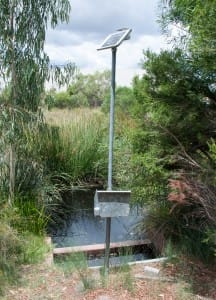“Not all wetlands are created equal”: report card on two Perth projects
 A highly variable climate, sensitive natural environment and growing population means Western Australian water and natural resource management agencies have a big challenge when it comes to creating more water sensitive suburbs.
A highly variable climate, sensitive natural environment and growing population means Western Australian water and natural resource management agencies have a big challenge when it comes to creating more water sensitive suburbs.
One strategy used by local councils and waterway managers is to use constructed or artificial wetlands to help treat and remove stormwater pollutants before they enter surface waterways and groundwater systems. Two examples of these treatment systems are the Wharf Street wetland in Cannington, a southeastern suburb of Perth, and Anvil Way basin, an artificial wetland in Welshpool.
The Wharf Street wetland was constructed to improve the quality of urban stormwater runoff and reduce nutrients and other contaminants entering the Canning River and Swan Coastal Plain from an urbanised 129ha catchment. The project involved the diversion of the Wharf Street main drain into a constructed wetland to improve water quality.
In 2010 works at the Anvil Way basin were undertaken to reconfigure an existing compensation basin to include a living stream through a partnership between the Swan River Trust, City of Canning, South East Regional Centre for Urban Landcare (SERCUL), Water Corporation and Public Transport Authority. Both sites have been the subject of regular monitoring.
While some excellent monitoring projects have been put in place and a large volume of data now exists, the Western Australian Department of Parks and Wildlife could see that bringing in outside help was necessary to analyse the mountain of data and provide useful recommendations for improving stormwater management at the two sites on the Swan Coastal Plain.
CRC for Water Sensitive Cities (CRCWSC) Researchers at the University of Western Australia, including Ana Laura Ruibal-Conti, Carlos Ocampo, Tanveer Adyel, Matthew Hipsey and Carolyn Oldham, were brought in to assess ten years of data at the Anvil Way Compensation Basin and five years worth at the Wharf St wetland.
The research is now largely complete and the findings have been published in two reports, Performance assessment of Wharf Street Constructed Wetland 2009-2014 and Performance assessment of the Anvil Way Compensation Basin living stream: 2004-2013, which form a research component of CRCWSC projects Integrated multi-functional urban water systems (Project C4.1) and Hydrology and nutrient transport processes in groundwater/surface water systems (Project B2.4).
Associate Professor Matt Hipsey said a key factor in the project was to determine how wetlands perform on a yearly and seasonal basis as stormwater management systems, what affects that performance and how they can be improved, given the lack of relevant historical research and data analyses.
“While there’s a lot of constructed wetlands, there’s a lack of locally relevant information about how they perform in the long term. Little is known about how they continue to perform years after they’re built, or from season to season,” he said.
“We tend to rely on simple assumptions of how wetlands work. Not all nutrients of concern are processed equally and not all wetlands are created equal. Design features can have a significant impact on their performance and we can use this as a learning experience to see what design features are effective and which aren’t.”
The assessment of both wetland systems found they were effective at removing nutrients such as nitrogen and phosphorus, with base sediment and wetland plants or macrophytes capturing a significant nutrient load.
Peter Adkins, Program Manager of Drainage and Nutrient Intervention at the Department of Parks and Wildlife (Rivers and Estuaries Division), said the analysis presented in the technical reports produced by the research team would help in management and monitoring, and the design of future constructed wetlands.
“These wetland and living stream projects are valuable demonstration sites that provide multiple benefits and as such are considered an important tool in assisting the transition to water sensitive cities. Parks and Wildlife involvement in the CRCWSC through these and other projects is addressing knowledge gaps to inform stormwater management and ultimately improved river health.”
The Wharf Street wetland project also received external recognition, picking up the 2015 Stormwater Western Australia Award for Excellence in the Research and Innovation category. As a result of winning this award the project is now automatically entered in the national SIA Awards.
Further reading: Artificial wetland improves water quality - DPAW media release.